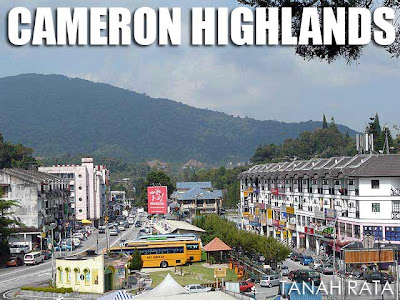 Cameron Highlands is Baguio City before it exploded. It's the most extensive hill station in Malaysia and became prosperous during the British colonial period of Malaysia when planters discovered that its fertile mountain slopes was perfect for growing tea, then a very important commodity.
Cameron Highlands is Baguio City before it exploded. It's the most extensive hill station in Malaysia and became prosperous during the British colonial period of Malaysia when planters discovered that its fertile mountain slopes was perfect for growing tea, then a very important commodity.
 I had booked a half-day tour of Cameron Highlands which was quite convenient. Our first stop for the day was the Rose Centre which is actually a botanical garden. Many of the flowers found in the garden are also seen in the Philippines, particularly Baguio City. But it was a nice walk up the hill with all the plants in full bloom.
I had booked a half-day tour of Cameron Highlands which was quite convenient. Our first stop for the day was the Rose Centre which is actually a botanical garden. Many of the flowers found in the garden are also seen in the Philippines, particularly Baguio City. But it was a nice walk up the hill with all the plants in full bloom.The main reason I wanted to see Cameron Highlands was to visit the tea plantations. And the BOH Tea Plantation, the largest tea plantation in Malaysia surely did not disappoint.

 The Sungei Palas Tea Centre of BOH currently has a well-equipped visitor center and is very welcoming to tourists. From the platform, you get a superb view of the plantations. Plus you could purchase some tea from the tea shop. It's a really great place to learn about Cameron Highlands, the benefits of tea, and the history of the BOH Tea Plantation which opened in 1929.
The Sungei Palas Tea Centre of BOH currently has a well-equipped visitor center and is very welcoming to tourists. From the platform, you get a superb view of the plantations. Plus you could purchase some tea from the tea shop. It's a really great place to learn about Cameron Highlands, the benefits of tea, and the history of the BOH Tea Plantation which opened in 1929. I got to walk around the small museum and a tea factory where they process the tea leaves. It's really informative getting to observe how natural and simple the tea making process really is.
I got to walk around the small museum and a tea factory where they process the tea leaves. It's really informative getting to observe how natural and simple the tea making process really is.After visiting the BOH Tea Plantation, we also passed by a bee farm and Market Square where you can purchase the local produce, flowers and other products from Cameron Highlands. There was a hawker who sold deep-fried battered vegetables which I enjoyed munching on.
Anyway, I was hoping to be back in Tanah Rata before the 1 p.m. departure of my bus back to Kuala Lumpur (the tour agent assured me I'd be back). But the half-day tour usually extends beyond 2 p.m. so I had to request the driver to bring me back to Tanah Rata while the other guests were in one of the attractions. As a result, I missed the the butterfly farm, strawberry farm and cactus farm which isn't much of a loss since that's something I'd see in La Trinidad and Baguio anyway.
Part 1: Bus trip from Penang to Cameron Highlands



















